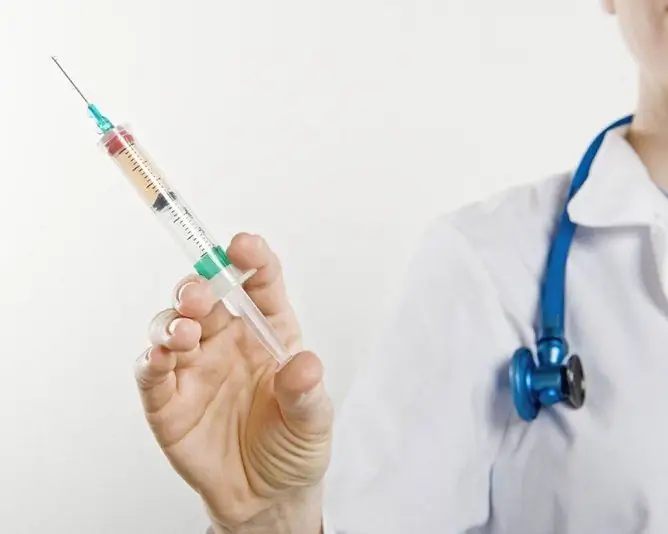- Author Rachel Wainwright [email protected].
- Public 2023-12-15 07:39.
- Last modified 2025-11-02 20:14.
Vitaxon
Vitaxon: instructions for use and reviews
- 1. Release form and composition
- 2. Pharmacological properties
- 3. Indications for use
- 4. Contraindications
- 5. Method of application and dosage
- 6. Side effects
- 7. Overdose
- 8. Special instructions
- 9. Application during pregnancy and lactation
- 10. Use in childhood
- 11. Drug interactions
- 12. Analogs
- 13. Terms and conditions of storage
- 14. Terms of dispensing from pharmacies
- 15. Reviews
- 16. Price in pharmacies
Latin name: Vitaxon
ATX code: N07XX
Active ingredient: thiamin + cyanocobalamin + pyridoxine + lidocaine (thiaminum + cyanocobalaminum + pyridoxinum + lidocaine)
Manufacturer: PJSC "Farmak" (Ukraine)
Description and photo update: 2019-23-08

Vitaxon is a complex preparation of B vitamins.
Release form and composition
Vitaxon dosage form is a solution for intramuscular (i / m) administration: a transparent red liquid with a characteristic odor (2 ml in glass ampoules, in a polymer blister 5 ampoules, in a cardboard box 1 or 2 blisters).
1 ml of solution contains:
- active ingredients [in terms of 100% dry (anhydrous) substance]: pyridoxine hydrochloride - 50 mg, thiamine hydrochloride - 50 mg, lidocaine hydrochloride - 10 mg, cyanocobalamin - 0.5 mg;
- excipients: sodium polyphosphate, sodium hydroxide solution 0.1 M, potassium hexacyanoferrate III, benzyl alcohol, water for injection.
Pharmacological properties
Pharmacodynamics
Vitaxon contains vitamins B 12 (cyanocobalamin), B 6 (pyridoxine) and B 1 (thiamine), the lack of which in the body can provoke neurological disorders, mainly from the peripheral nervous system. This tool quickly eliminates the deficiency of the above vitamins.
Thiamine is a cofactor for enzymes that transport groups that include two carbon atoms in decarboxylation reactions. Cyanocobalamin is a cofactor involved in transport reactions of groups containing one carbon atom. Pyridoxine belongs to the cofactors of transaminases, and is also a cofactor in several other reactions associated with the metabolism of amino acids.
Lidocaine has a local anesthetic effect that provides all types of local anesthesia: conduction, infiltration, terminal.
Pharmacokinetics
When administered intramuscularly, thiamine is absorbed at a high rate from the injection site and enters the bloodstream (15 minutes after the injection of 50 mg of Vitaxone on the first day of use, the concentration of the substance is 484 ng / ml). Vitamin B 1it is distributed unevenly in the body: in blood plasma its content does not exceed 10%, in leukocytes it reaches 15%, and in erythrocytes - 75%. This substance crosses the blood-brain and placental barriers and is found in breast milk. Thiamine is excreted through the kidneys in the α-phase 0.15 hours after administration, in the β-phase - after 1 hour, in the terminal phase - within 2 days. Pyramine, thiamincarboxylic acid and a number of unknown metabolic products are the main metabolites. Of all vitamins, thiamine is accumulated in minimal amounts. The body of an adult contains approximately 30 mg of vitamin B 1, 10% of which is in the form of thiamine triphosphate, 80% in the form of thiamine pyrophosphate, and the rest in the form of thiamine monophosphate.
When administered intramuscularly, pyridoxine is rapidly absorbed into the systemic circulation and is distributed in organs and tissues. Its active metabolite is pyridoxal phosphate, which is formed during the phosphorylation of the CH 2 OH group in the 5th position. Approximately 80% of vitamin B 6 binds to plasma proteins. Pyridoxine is distributed throughout the body, crosses the placental barrier and is detected in breast milk. The substance is deposited in the liver and participates in oxidative reactions, forming 4-pyridoxinic acid, which is excreted in the urine (the maximum elimination time is 2-5 hours after absorption). The human body contains 40 to 150 mg of pyridoxine, and its daily elimination rate is approximately 1.7-3.6 mg, with a vitamin replacement rate of 2.2 to 2.4%.
After parenteral administration, cyanocobalamin forms complexes with the transport protein transcobalamin, which are rapidly absorbed by the bone marrow, liver and other organs. Vitamin B 12 is excreted in the bile and participates in the processes of intestinal-hepatic recirculation, and also penetrates the placental barrier.
Indications for use
According to the instructions, Vitaxon is used as part of the complex therapy of the following pathologies:
- neuropathic pain associated with diabetic, alcoholic and other types of polyneuropathies;
- neuralgia and neuritis: trigeminal neuralgia, intercostal neuralgia, pain syndrome in diseases of the spine (lumboischialgia, dorsalgia, plexopathy, radicular syndrome in degenerative changes in the spine), neuritis of the facial nerve.
Contraindications
- acute decompensated heart failure;
- severe conduction disturbances in the cardiac conduction system;
- the period of pregnancy and breastfeeding [due to the high (100 mg per ampoule) content of vitamin B 6];
- childhood;
- individual intolerance to Vitaxone components.
Instructions for the use of Vitaxon: method and dosage
Vitaxon injections are administered deeply intramuscularly.
Recommended dosage:
- severe and / or acute pain syndrome: 2 ml once a day for several days (the period necessary to achieve a sufficient level of drug concentration in blood plasma);
- a mild form of combat syndrome, including after a decrease in severe pain: 2 ml once a day every 2-3 days, in the intervals between i / m injections, similar oral dosage forms should be taken.
The use of Vitaxon must be accompanied by weekly medical supervision, which will allow, when the clinical condition improves, to transfer the patient to the intake of similar drugs inside as soon as possible.
Side effects
The use of Vitaxon can cause the development of the following undesirable effects:
- in some cases: increased sweating, tachycardia, acne, skin reactions (including itching, urticaria), hypersensitivity reactions in the form of a rash, shortness of breath, anaphylactic shock, angioedema;
- rarely: due to benzyl alcohol in the drug - hypersensitivity reactions;
- frequency unknown: burning sensation at the injection site;
- others: against the background of the rapid intake of the drug into the body (caused by the introduction into blood-rich tissues or unintentional intravascular administration) or excess of the dose - systemic reactions, including dizziness, vomiting, confusion, arrhythmia, bradycardia, convulsions.
Overdose
An overdose of Vitaxon can lead to an increase in the severity of adverse reactions: excessive sweating, dizziness, bradycardia, arrhythmias, nausea, seizures. In this case, you must immediately consult a doctor who will prescribe symptomatic treatment.
special instructions
Vitaxone should not be allowed to enter the vascular bed, in case of unintentional intravenous administration, the patient needs careful medical supervision in a hospital.
Long-term (more than 6 months) use of the drug can cause the development of neuropathy.
The sodium content in 2 ml of solution is less than 23 mg (1 mmol).
Influence on the ability to drive vehicles and complex mechanisms
The use of Vitaxon does not affect the patient's ability to control mechanisms and vehicles.
Application during pregnancy and lactation
The recommended daily intake of vitamin B 1 when used in pregnant and lactating women is 1.4-1.6 mg, and vitamin B 6 is 2.4-2.6 mg. Exceeding these doses during pregnancy is permissible only with a precisely diagnosed deficiency of thiamine and pyridoxine, since the safety of introducing these vitamins in doses exceeding the required daily requirement has not been proven. Also, vitamins B 1 and B 6 are determined in breast milk, and high doses of vitamin B 6 reduce milk production. For these reasons, the use of Vitaxone during pregnancy and lactation is contraindicated.
Pediatric use
Vitaxon is not prescribed for children and adolescents under the age of 18 due to the lack of experience in this category of patients.
Drug interactions
With the simultaneous use of Vitaxon:
- sulfite-containing solutions contribute to the complete degradation of thiamine, the presence of decomposition products of vitamin B 1 can inactivate other vitamins in the solution;
- levodopa may reduce its therapeutic effect;
- epinephrine and norepinephrine, due to the presence of lidocaine in the drug, increase the risk of adverse reactions from the heart (in case of an overdose of local anesthetics, they are not allowed).
In addition, interaction with penicillamine, isoniazid, cyclosporine, sulfonamides is possible.
Analogs
Vitaxon analogs are: Hypoxen, Neurox, Vitagamma, Trigamma, Kombilipen, Meksiprim, Meksidant, Meksidol, Cytoflavin.
Terms and conditions of storage
Keep out of the reach of children.
Store at temperatures up to 15 ° C in a dark place.
Shelf life is 2 years.
Terms of dispensing from pharmacies
Dispensed by prescription.
Reviews about Vitaxone
Basically, doctors and patients leave favorable reviews about Vitaxone. They confirm its effectiveness and low risk of developing adverse reactions, however, it is advised to use the drug only after consulting a specialist. It eliminates back pain (for example, with osteochondrosis) and inflammatory processes in the nerve tissues and muscles, relieves pain and stiffness in the joints. Sometimes the drug is prescribed by gastroenterologists for intestinal inflammation. However, Vitaxon's injections can be quite painful.
Price for Vitaxon in pharmacies
The approximate price for Vitaxon in pharmacy chains is 162-211 rubles (per package containing 5 ampoules).

Anna Kozlova Medical journalist About the author
Education: Rostov State Medical University, specialty "General Medicine".
Information about the drug is generalized, provided for informational purposes only and does not replace the official instructions. Self-medication is hazardous to health!






